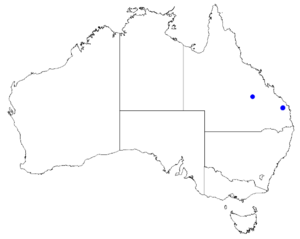Boronia foetida facts for kids
Quick facts for kids Boronia foetida |
|
|---|---|
| Scientific classification | |
 |
|
| Occurrence data from Australasian Virtual Herbarium |
Boronia foetida is a special kind of plant that belongs to the citrus family, called Rutaceae. It's a shrub that only grows in a small part of Queensland, Australia. This plant has hairy branches and simple leaves. Its flowers are usually pink to white and have four petals. One interesting thing about Boronia foetida is that its leaves have a really unpleasant smell when you crush them!
Contents
What Does Boronia foetida Look Like?
Boronia foetida is an upright shrub with many hairy branches. It can grow up to about 2 m (7 ft) tall. It has simple leaves that are shaped like an oval, called elliptic. These leaves are about 20–52 mm (0.8–2 in) long and 7–14 mm (0.3–0.6 in) wide. They grow on a small stalk called a petiole, which is about 2–7 mm (0.08–0.3 in) long. Sometimes, the top of the leaf has a few hairs along its middle line.
When you crush the leaves, they give off a very unpleasant smell. The flowers are pink to white. They usually grow one by one where the leaf meets the stem, on a tiny stalk called a pedicel. This stalk is about 2–2.5 mm (0.08–0.1 in) long.
Flower Parts
Each flower has four pointed parts called sepals, which are like small leaves protecting the bud. They are about 2–4 mm (0.08–0.2 in) long and 1.5–3 mm (0.06–0.1 in) wide. The four petals are about 6–7 mm (0.24–0.28 in) long. As the plant grows fruit, these petals get a bit longer, reaching about 8 mm (0.31 in).
Inside the flower, there are eight hairy stamens. These are the parts that make pollen. They have a large tip called an anther. The part that receives pollen, called the style, is smooth and hairless, or glabrous. Boronia foetida flowers bloom from May to September. After flowering, it produces a smooth, hairless fruit called a capsule.
How Was Boronia foetida Named?
The plant Boronia foetida was officially described for the first time in 1999. This was done by a scientist named Marco F. Duretto. He wrote about it in a science journal called Austrobaileya. He studied a plant sample that was found near Biggenden.
The second part of its scientific name, foetida, comes from a Latin word. It means "stinking" or "smelly." This name was chosen because of the very unpleasant smell of the leaves when they are crushed. People have said the smell is "reminiscent of a dead possum," which means it smells a bit like a dead possum.
Where Does Boronia foetida Grow?
This special boronia plant grows in different types of places. You can find it in mountain heath areas, which are open spaces with small shrubs. It also grows in thick forests found in gullies, which are small valleys. Boronia foetida is only known to grow in one specific area: near Mount Walsh, close to Biggenden in Queensland.
Is Boronia foetida in Danger?
The Queensland Government's Department of Environment and Heritage Protection keeps track of plants and animals. They have classified Boronia foetida as "least concern." This means that, for now, there are enough of these plants, and they are not considered to be in danger of disappearing.

